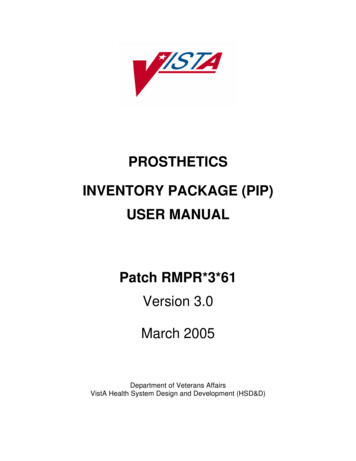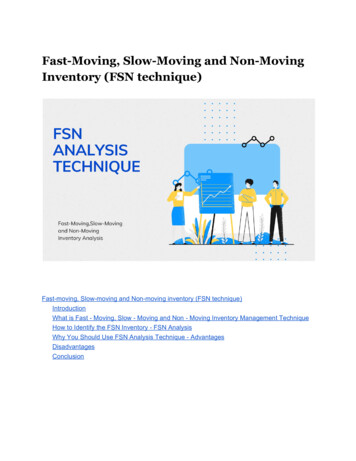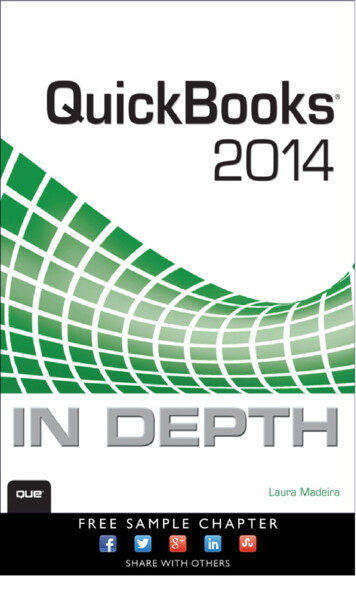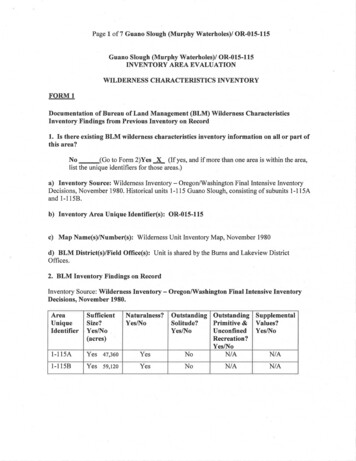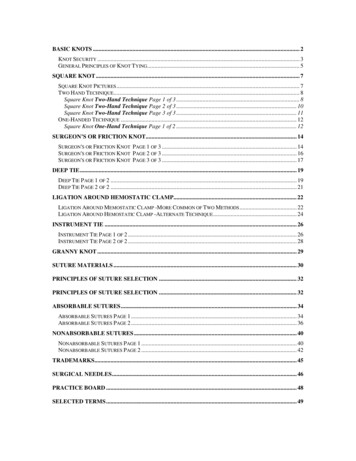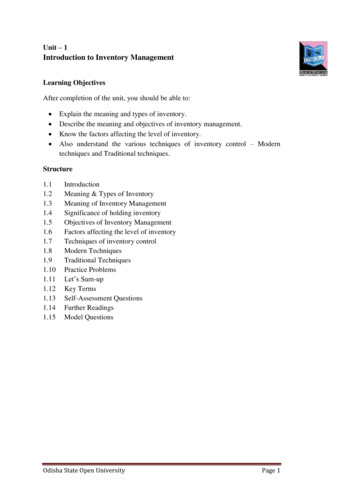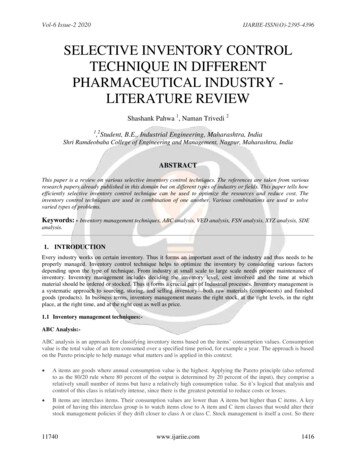
Transcription
Vol-6 Issue-2 2020IJARIIE-ISSN(O)-2395-4396SELECTIVE INVENTORY CONTROLTECHNIQUE IN DIFFERENTPHARMACEUTICAL INDUSTRY LITERATURE REVIEWShashank Pahwa 1, Naman Trivedi 212, Student, B.E., Industrial Engineering, Maharashtra, IndiaShri Ramdeobaba College of Engineering and Management, Nagpur, Maharashtra, IndiaABSTRACTThis paper is a review on various selective inventory control techniques. The references are taken from variousresearch papers already published in this domain but on different types of industry or fields. This paper tells howefficiently selective inventory control technique can be used to optimize the resources and reduce cost. Theinventory control techniques are used in combination of one another. Various combinations are used to solvevaried types of problems.Keywords: - Inventory management techniques, ABC analysis, VED analysis, FSN analysis, XYZ analysis, SDEanalysis.1. INTRODUCTIONEvery industry works on certain inventory. Thus it forms an important asset of the industry and thus needs to beproperly managed. Inventory control technique helps to optimize the inventory by considering various factorsdepending upon the type of technique. From industry at small scale to large scale needs proper maintenance ofinventory. Inventory management includes deciding the inventory level, cost involved and the time at whichmaterial should be ordered or stocked. Thus it forms a crucial part of Industrial processes. Inventory management isa systematic approach to sourcing, storing, and selling inventory—both raw materials (components) and finishedgoods (products). In business terms, inventory management means the right stock, at the right levels, in the rightplace, at the right time, and at the right cost as well as price.1.1 Inventory management techniques:ABC Analysis:ABC analysis is an approach for classifying inventory items based on the items’ consumption values. Consumptionvalue is the total value of an item consumed over a specified time period, for example a year. The approach is basedon the Pareto principle to help manage what matters and is applied in this context: A items are goods where annual consumption value is the highest. Applying the Pareto principle (also referredto as the 80/20 rule where 80 percent of the output is determined by 20 percent of the input), they comprise arelatively small number of items but have a relatively high consumption value. So it’s logical that analysis andcontrol of this class is relatively intense, since there is the greatest potential to reduce costs or losses. B items are interclass items. Their consumption values are lower than A items but higher than C items. A keypoint of having this interclass group is to watch items close to A item and C item classes that would alter theirstock management policies if they drift closer to class A or class C. Stock management is itself a cost. So there11740www.ijariie.com1416
Vol-6 Issue-2 2020IJARIIE-ISSN(O)-2395-4396needs to be a balance between controls to protect the asset class and the value at risk of loss, or the cost ofanalysis and the potential value returned by reducing class costs. So, the scope of this class and the inventorymanagement policies are determined by the estimated cost-benefit of class cost reduction, and loss controlsystems and processes. C items have the lowest consumption value. This class has a relatively high proportion of the total number oflines but with relatively low consumption values. Logically, it’s not usually cost-effective to deploy tightinventory controls, as the value at risk of significant loss is relatively low and the cost of analysis wouldtypically yield relatively low returns.VED Analysis:It attempts to classify the items used into three broad categories, namely Vital, Essential, and Desirable. The analysisclassifies items on the basis of their criticality for the industry or company. Vital: Vital category items are those items without which the production activities or any other activity ofthe company, would come to a halt, or at least be drastically affected. Essential: Essential items are those items whose stock – out cost is very high for the company. Desirable: Desirable items are those items whose stock-out or shortage causes only a minor disruption fora short duration in the production schedule.The cost incurred is very nominal. VED Analysis is very useful to categorize items of spare parts and components.In fact, in the inventory control of spare parts and components it is advisable, for the organization to use acombination of ABC and VED Analysis. Such control system would be found to be more effective and meaningful.FAST, SLOW & NON-MOVING (FSN) Analysis:This method of inventory control is very useful for controlling obsolescence. All the items of inventory are notused in the same order; some are required frequently, while some are not required at all. So this method classifiesinventory into three categories, fast-moving inventory, slow-moving inventory, and non-moving inventory. Theorder for new inventory is placed based on the utilization of inventory.XYZ AnalysisXYZ analysis is one of the basic supply chain techniques, often used to determine the inventory valuation insidea Stores. It's also strategic as it intends to enable the Inventory manager in exercising maximum control over thehighest stocked item , in terms of stock value.The XYZ analysis is a way to classify inventory items according to variability of their demand. X class items which are critically important and require close monitoring and tight control – while this mayaccount for large value these will typically comprise a small percentage of the overall inventory count. Y class are of lower criticality requiring standard controls and periodic reviews of usage.Z class require the least controls, are sometimes issues as “free stock” or forward holdingGOLF Classification:The letter stands for Government, Ordinary, Local and Foreign. There are mainly imported items which arecanalized through the State Trading Corporation (STC) Minerals and Metals Trading Corporation, etc. IndianDrugs and Pharmaceutical Ltd (IDPL), Mica trading corporation etc. These are special procedures of inventorycontrol which may not applicable to ordinary items as they require special procedures.11740www.ijariie.com1417
Vol-6 Issue-2 2020IJARIIE-ISSN(O)-2395-4396High Medium Low (HML) Classification:HML Analysis classifies inventory based on how much a product costs/its unit price.The HML classification is same procedure as adopted in ABC. High Cost (H) – Item with a high unit value. Medium Cost (M) – Item with a medium unit value. Low Cost (L) – Item with a low unit value.The core difference is, for HML classification; unit value is the criterion and not the annual consumption value. Theinventories should be place in descending order and it is up to management to fix limits of these three categories.Example: the management may decide all units of items with unit value of Rs 2,000 and above will be H items;between Rs. 2000-1000 will be M items & those below Rs. 1000 will be L items.SOS Classification:SOS analysis is based on seasonality of items and it classifies all the items into two categoriesS- Seasonal0S- Off seasonalThe analysis helps in:1.Identifying items that are available only during a limited period of the year .For e.g. Raw mangoes are onlyavailable only during a summers2. Identifying items that are seasonal but available throughout the year however their costs in offseason arerelatively high.3. Non Seasonal itemsAs discussed above there are a number of methods used for selective inventory control and each method highlights adifferent aspect .The right method should be selected on the purpose for which we wish to carry out the selectiveinventory control.SDE Analysis:The criterion for this analysis is the availability of the materials in the market. In industrial situations where certainmaterials are scarce (especially in a developing country like India) this analysis is very useful and gives properguideline for deciding the inventory policies.D stands for difficult items, items which are not readily available in local markets and have to be procured fromfaraway places, or items for which there are a limited number of suppliers; or items for which quality suppliers aredifficult to get.E refers to items which are easily available in the local markets11740www.ijariie.com1418
Vol-6 Issue-2 2020IJARIIE-ISSN(O)-2395-43962. REVIEW WORKPaper TitleAuthor(s)Inventorycontroltechnique usedSr.No.1ABC and VEDAnalysis inMedical StoresInventory Control2MedicineInventoryManagement byABC-VEDAnalysis in thePharmacy Store ofVeterinaryHospital,Yogyakarta,IndonesiaIda Fitriana , RadenGagak DonnySatria and Dwi CahyoBudi Setiawan3ABC-VEDanalysis ofexpendablemedical stores at atertiary carehospitalKumar S, Chakravarty A11740R Gupta, KKGupta, BR Jainand RK GargABC and VEDanalysisABC and VEDanalysisABC and VEDanalysiswww.ijariie.comSummaryIn this research paper we saw thatcoupling the two techniques ABC-VEDmatrix was made and drugs wereclassified in to Category I(AV BV CV AE AD) comprising 68drugs, Category II (BE CE BD) 159and Category III (CD) 98 drugs. Themanagement of Category I drugs wasmonitored by top management resultingin better control on the annual expensesand at the same time making available thevital Category II by middle and CategoryIII at lower managerial level.The ABC-VED analysis can be adopted indrug inventory of hospital drugmanagement so that it can plan theavailability of drugs efficiently the qualityof patient care.Scientific inventory management toolsneed to be applied routinely for efficientmanagement of medical stores, as itcontributes to judicious use of limitedresources and resultant improvement inpatient care.1419
Vol-6 Issue-2 20204A Case Study ofInventoryAnalysis in (O)-2395-4396Mohd Kamarul IrwanAbdul Rahim, QuamrulHassan, S.R. Nadarajah,Kamaruddin RadzuanABC and VEDanalysiswe used ABC classification as animportant technique to categorize theinventory in three different classesdepending on their significance.ABC analysis was usedin order to controlthe inventory items more efficiently.Seven products are categorized in Class A,eight products are categorized in Class Bwhereas seven products are categorized inClass C.5ABC and VEDAnalysis of thePharmacy Store ofa Tertiary CareTeaching,Research andReferralHealthcareInstitute of IndiaDevnani M, Gupta AK,Nigah RABC and VEDanalysisAs we can see that in this research Items ofapproximately Rs. 40,012,612 were issuedby the pharmacy store of PGIMER. Thisnecessitates application of scientificinventory management tools for effectiveand efficient management of the pharmacystores, efficient priority setting, decisionmaking in purchase and distribution ofspecific items and close supervision onitems belonging to important categories.with the help of ABC and VED analysiswe could identify the drugs required forstringent control for optimal use of fundsand elimination of out-of-stock situationsin the pharmacy.6Prioritized fsnanalysis ofinventorymanagement inprivate andhospital pharmacyfollowed byquestionnaireManivel P , RajeshRanganathanABC & FSNanalysisIn this research paper the pharmacypurchasing and the stock maintenanceprocedure has been observed through aquestionnaire and then the constraints andproblems faced by the hospital inventorymanagement to be overcome byimplementing a new inventory model.Then formed the priority based ABC –FSN inventory matrix and narrowed downthe drugs for monitoring and controlstrategies of pharmacy drugs.7A Study on theSelective Controlsof InventoryManagement AndApplication ofDr.K.V.KrishnaReddy,Dr.M.S.SiddarthSai, Dr.Rakesh PrabhuABC and XYZanalysisIn this research we can see variousaspects because of which we canunderstand the importance of inventory.We can see that a classification is adoptedso that a major portion of effective11740www.ijariie.com1420
Vol-6 Issue-2 2020IJARIIE-ISSN(O)-2395-4396ABC XYZControl Matrix inthe CardiologyDepartment of ATertiary CareHospital.managerial time is spent on thosematerials, which are more important. Themotive behind any selective control is thatequally detailed analysis of all items isvery expensive. Moreover such aconcentration on all items will havediffused effect regardless of the priorities.Selective inventory control can indicatewhere the manager should concentrate hisefforts8ABC-VEN MatrixAnalysis of thePharmacy Store ina Secondary LevelHealth CareFacility inArbaminch Town,Southern EthiopiaBiruk WogayehuTaddele, AyalewuAdinewu Wondimagegn, Mulugeta Asfaw Asaro,Mende Mensa Sorato ,Bisrat Gissila Gedayi ,Anidinet AssefaHailesilaseABC and VENanalysisIn this research paper the analysis showedthat the drug expenditure of a generalhospital medical store. This demandsefficient and effective inventory controltechnique so as to make right utilization ofbudget by concentrating on vital oressential medicines based on ABC-VENmatrix analysis. Using ABC-VEN analysisfinding medicines requiring strictmonitoring for effective and efficientbudget utilization. This analysis should bedone before and after the procurement ofmedicine.9Multi UnitSelectiveInventoryControl- A ThreeV.R. Girija and Prof.M.S. BhatABC ,SED andVED analysisThe basic objective or the requirement inthis research was to stop the stock-out.Computerization, automation and use oftechnique like MUSIC-3D will aid inachieving these objectives.DimensionalApproach(MUSIC -3D)10SIGNIFICANCEOFCONSUMPTIONPATTERNS ANDABC/FSN11740It is imperative that all measures for theprevention of stock out situations shouldbe implemented. We also came to knowavailability of pharmaceutical products isessential for patient satisfaction. It is alsoan essential requisite for provision of lifesaving, effective and efficienthealthcare. Frequency of stock outs isan indicator to assess the effectiveness ofthe stores department and the materialsmanagement.Nang Nwe Ni Hlaing* ,Cha-oncin Sooksriwong,Farsai Chanjaruporn,Oraluck PattanaprateepABC and FSNanalysiswww.ijariie.comIn this research paper the categorization ofvital drugs according to ABC/FSN matrixbenefits hospital to determine the level ofinventory with minimum investment indead-stock or slow-moving items. For1421
Vol-6 Issue-2 2020IJARIIE-ISSN(O)-2395-4396MATRIX TOOPTIMIZEVITAL DRUGSINVENTORYMANAGEMENTinventory management of vital drugs, onlyABC and VEN matrix classification areinsufficient to control the stock inappropriate level with minimum shortageand oversupply. Moreover, considerationof demand consumption patterns inforecasting and setting inventory level givean accurate stock level for optimization ofvital drugs inventory management. We cantherefore effectively understand thefunctioning and importance of ABC andFSN analysis in the same.11A Study on ABCXYZ Analysis ina Pharmacy StoreDr. Babu Krishnaraj R ,Meenakshi P KABC and XYZanalysisFrom this research paper we haveconcluded that there is a need forconducting such analysis regularly andapplying the inventory management toolsfor effective and efficient management inthe pharmacy stores, along with closesupervision on items belonging toimportant categories. We got desiredresults using the combination of ABC andXYZ analysis and therefore the inventoryclassification and results of the study arebeing incorporated in the decision makingon purchases, storage, investment andmonitoring of the pharmacy items.12Drug Inventorycontrol analysis ina Primary levelHealth carefacility in RuralTamil Nadu, IndiaGeetha Mani , KalaivaniAnnadurai , RajaDanasekaran , JegadeeshRamasamy DABC and VEDanalysisIn this research paper the drug inventoryanalysis using ABC and VED analysisenabled their classification into categoriesbased on their priority and assignment toappropriate managerial levels. Thisanalysis is hoped to promote effectivemanagement of drug inventory withminimal monetary resources whilemaintaining required safety stocks of highpriority drugs and reduce frequency ofdrug supply shortage. An efficientinventory management using the results ofthis study can create an effective system ata primary health care level will contributeto provision of uncompromised patientcare.13Application ofABC and VEDAnalysis for aPharmaceuticalKaushik Nag*,Mohammed AnanyABC and VEDanalysisFrom the study in this research paper, theABC–VED analysis was found to be aneffective inventory tool for identifying thedrugs requiring stringent control for11740www.ijariie.com1422
Vol-6 Issue-2 ory inKuwaitoptimal use of financial resources andelimination of out-ofstock situations. Thestudy revealed that only 27% of items canbe considered as vital and costly,accounting for a high 71% of the AnnualDrug Expenditure. Such items thereforerequire maximum level of control,eliminating the need for equal focus on theremaining items, for which, moderate tolow control may be deemed enough. Suchcategorization of items therefore leads toan efficient priority setting, decisionmaking in purchase and distribution andclose supervision of specific item and wecan come to this conclusion only by usingeffective ABC and VED analysis.14The integratedabc/fmr/vedanalysis of drugconsumptionamong hospicepatientsSofiya Prokip* andBohdan HromovykABC/FMR/VEDANALYSISThis research paper was a bit differentfrom the papers we were analysing till nowas in this not one or two but three methodsof inventory management is used to get thedesirable results. This paper shows that139 international non-proprietary names ofdrugs from 42 therapeutic groups of ATCclassification system were used inpharmacotherapy of patients. The study ofdrug consumption was based on integratedABC / FMR / VED-analysis, which isirreplaceable and useful for themanagement decisions in order to optimizethe assortment balance of medicines. It hasbeen found that the highest expenses in thepharmacotherapy of hospice patients areassociated with analgesics andpsycholeptics, which is related to theranking position of those groups of drugsby the frequency of prescribing.15Analysis ofInventory of Drugand PharmacyDepartment of aTertiary careHospitalManhas Anil K, MalikAubid, Haroon Rashid,Sheikh Mushtaq A, SyedATABC and VEDanalysisIn this research paper the study hasanalyzed the inventory of drugs as pertheir cost and criticality. It is expected toguide the management to delegate theresponsibility to different officers andapply the “Principle of Management byException”. Moreover it will facilitate themanagement in controlling the cost andensure the availability of vital andessential items in the hospital which willbe in the interest of patients and the11740www.ijariie.com1423
Vol-6 Issue-2 2020IJARIIE-ISSN(O)-2395-4396administration. There are also othersuggestions given to the hospitalmanagement on the bases of resultsachieved from the ABC and VED analysis.3. CONCLUSIONSThis review paper attempted to provide an overview of different inventory management techniques which are usedin solving the various inventory control problems in the pharmaceutical and healthcare industry.The efficiency of inventory management has become an area of major concern for any organisation. Everyorganisation wants to improve their inventory management as this is the major tool that's leads to the success of theorganisation.The different conclusions which were drawn from the study are as follows * Many researchers have used ABC analysis as it is one of the most simple inventory control technique to applywith consideration of the consumption of the materials used. But if the main concern is to reduce the inventory costthen ABC technique alone is not feasible. The combination of either ABC and VED or ABC and FSN is used foroptimising the cost for management of inventory.* When XYZ inventory control technique is used by the researchers the analysis is done in the following manner bydividing all the items in 3 parts, the most critical items are kept in X class, the items which are less critical are keptin Y class and the remaining items which are least critical are kept in Z class.4. REFERENCESR Gupta, KK Gupta, BR Jain and RK Garg,” ABC and VED Analysis in Medical Stores Inventory Control”,Med J Armed Forces India , DOI 2011 Jul 21.2. Ida Fitriana , Raden Gagak Donny Satria and Dwi Cahyo Budi Setiawan,” Medicine Inventory Managementby ABC-VED Analysis in the Pharmacy Store of Veterinary Hospital, Yogyakarta, Indonesia” Asian JournalOf Animal And Veterinary Advances,vol.13 DOI 20183. Kumar S, Chakravarty A , “ABC-VED analysis of expendable medical stores at a tertiary care hospital” MedJ Armed Forces India, doi: Sept 4 20144. Mohd Kamarul Irwan Abdul Rahim, Quamrul Hassan, S.R. Nadarajah, Kamaruddin Radzuan, “A Case Studyof Inventory Analysis in a Healthcare Product Manufacturing Company” Int. J Sup. Chain. Mgt Vol. 7, No. 3,June 20185. Devnani M, Gupta AK, Nigah R, “ABC and VED Analysis of the Pharmacy Store of a Tertiary CareTeaching, Research and Referral Healthcare Institute of India” J Young Pharm. 2010 Apr-Jun6. Manivel P , Rajesh Ranganathan, “Prioritized Fsn Analysis Of Inventory Management In Private AndHospital Pharmacy Followed By Questionnaire” Int. Res. J. Pharm. 2016, 7 (12)7. Dr.K.V.Krishna Reddy,Dr.M.S.Siddarth Sai, Dr.Rakesh Prabhu, “A Study on the Selective Controls ofInventory Management And Application of ABC XYZ Control Matrix in the Cardiology Department of ATertiary Care Hospital” OSR Journal of Dental and Medical Sciences 16(05):06-09 · May 20178. Biruk Wogayehu Taddele, Ayalewu Adinewu Wondimagegn , Mulugeta Asfaw Asaro, Mende Mensa Sorato ,Bisrat Gissila Gedayi , Anidinet Assefa Hailesilase, “ABC-VEN Matrix Analysis of the Pharmacy Store in aSecondary Level Health Care Facility in Arbaminch Town, Southern Ethiopia” Journal of YoungPharmacists, 2019; 11(2)9. V.R. Girija and Prof. M.S. Bhat, “Multi Unit Selective Inventory Control- A Three Dimensional Approach(MUSIC -3D)” CVR Journal of Science and Technology, Volume 5, December 201310. Nang Nwe Ni Hlaing* , Cha-oncin Sooksriwong, Farsai Chanjaruporn, Oraluck Pattanaprateep,“SIGNIFICANCE OF CONSUMPTION PATTERNS AND ABC/FSN MATRIX TO OPTIMIZE VITALDRUGS INVENTORY MANAGEMENT”, Journal of Management And Pharmacy Practice, Volume7Nomor 3–September 20171.11740www.ijariie.com1424
Vol-6 Issue-2 2020IJARIIE-ISSN(O)-2395-439611. Dr. Babu Krishnaraj R , Meenakshi P K, “A Study on ABC-XYZ Analysis in a Pharmacy Store” InternationalJournal of Mathematics and Statistics Invention (IJMSI), Volume 4 Issue 9 , November. 201612. Geetha Mani , Kalaivani Annadurai , Raja Danasekaran , Jegadeesh Ramasamy D, “Drug Inventory controlanalysis in a Primary level Health care facility in Rural Tamil Nadu, India” Healthline ,Volume 5 Issue 2July December 201413. Kaushik Nag*, Mohammed Anany, “Application of ABC and VED Analysis for a PharmaceuticalDistributor’s Inventory in Kuwait” Proceedings of the 2016 Industrial and Systems Engineering ResearchConference, May 201614. Sofiya Prokip* and Bohdan Hromovyk, “The Integrated Abc/Fmr/Ved-Analysis Of Drug ConsumptionAmong Hospice Patients” International Journal Of Pharmaceutical Sciences And Research, DOI 01 January,201415. Manhas Anil K, Malik Aubid, Haroon Rashid, Sheikh Mushtaq A, Syed AT, “Analysis of Inventory of Drugand Pharmacy Department of a Tertiary care Hospital” JIMSA Vol.25 No.3 July-September 201211740www.ijariie.com1425
This method of inventory control is very useful for controlling obsolescence. All the items of inventory are not used in the same order; some are required frequently, while some are not required at all. So this method classifies inventory into three categories, fast-moving inventory, slow-moving inventory, and non-moving inventory. The




